Sony Ericsson 2003 Product Launch
Here are some highlights from the press conference this morning.
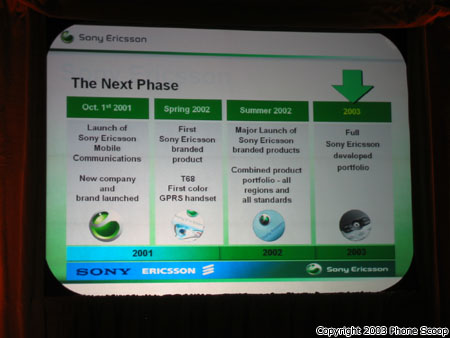
The presentation started off with a basic strategy overview. With today's announcements, Sony Ericsson now has a full portfolio of phones designed from the beginning by the joint company (as opposed to older Sony-designed and Ericsson-designed models).
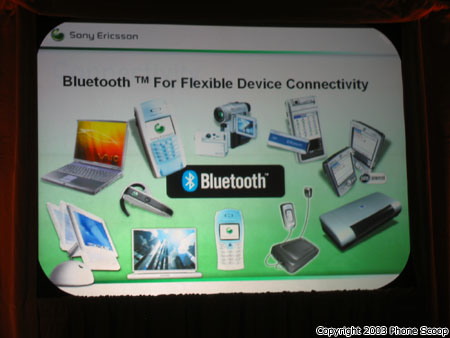
Sony Ericsson has always been a leader in Bluetooth technology, and that continues with today's new phones. Interestingly, it was specifically mentioned that Apple has made a big deal about wanting more Bluetooth phones on the market.
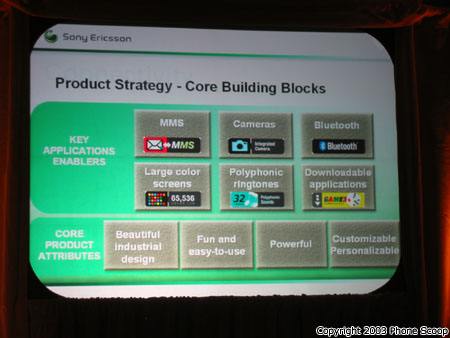
These are the feature areas Sony Ericsson is focusing on this year. Most are standard for the industry, except for Bluetooth, which other companies don't seem to be stressing as much.
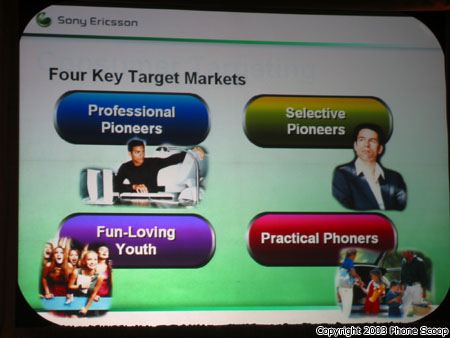
The four types of mobile consumers, as envisioned by Sony Ericsson. The "Selective Pioneer" is an interesting category I don't recall seeing companies talk about before. These are the folks who like the more advanced technology, but shy away from the bleeding edge. For example, these might be people who are buying the T68i around now.
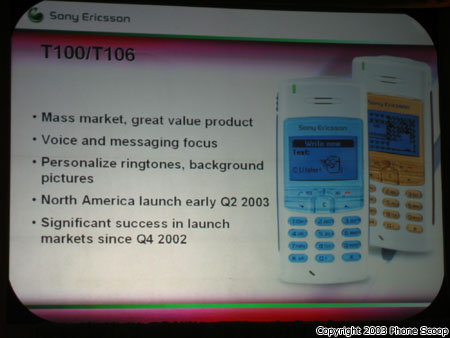
The T100 and T106 have sold "suprisingly well" in many markets. For example, it quickly become a #1 seller in Hong Kong, bucking the trend toward higher-end phones in that market. This phone fits into the "Practical Phoners" category - people who just want the basic voice functionality, and couldn't care less about other features. Even though the flashy phones get all the attention, it's worth noting that the low end is actually expanding and doing well.
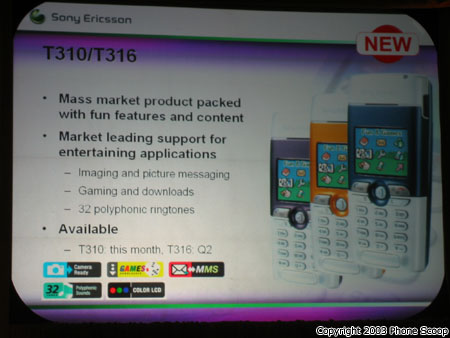
On to the first new phone. The T310 and T316 are an upgrade to the T300 and T306. The polyphonic ringtones are improved (32 vs. 24 voices), as well as the gaming & imaging features. The T310 is available this week, while the T316 (with GSM 850/1800/1900 for the Americas) should be available in the second quarter.
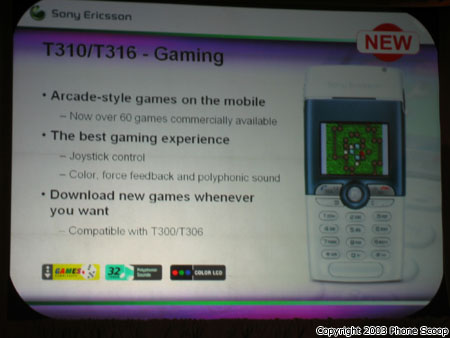
The emphasis with the T31x is on gaming. The phones use the Mophun platform, for which over 60 games are now available. All three major US GSM carriers have agreed to support the Mophun platform. Mophun games will also be downloadable from Sony Ericsson's website, which will be available to US consumers as well as the rest of the world.
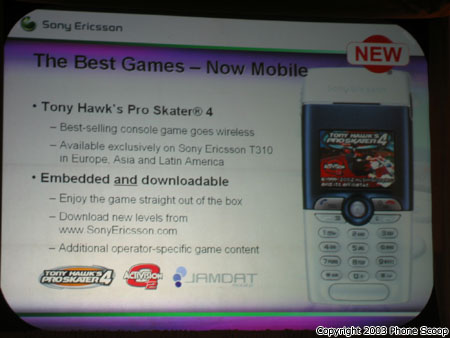
Tony Hawk's Pro Skater 4 will be the headline game included with the phone. Wireless gaming was emphasized. One interesting comment was that Sony Ericsson is working on creating multi-platform multi-player wireless games, which will allow users to play games on their phones against friends on PlayStation consoles - over the Internet, in real time. Details have not been announced, but "the technology is there", and Sony Ericsson plans to have these types of games launched by the end of the year.
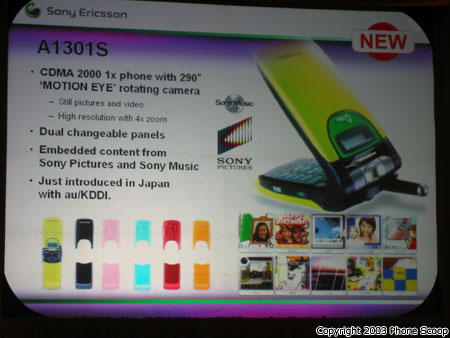
This is a new Sony Ericsson phone for Japan. Advanced phones like this come out in Japan first, because the Japanese will readily pay twice as much for a phone compared to Western consumers. The technology reaches the rest of the world once the price point can be brought down. There is one notable feature of this phone that is relevant to the West, however - Sony plans to leverage its media assets more in future Sony Ericsson phones. For example, expect to see things like battery cover/ringtone/graphic combo-packs, themed around Sony Music artists. Things like Cingular's "Spider Man phone" should be more common.
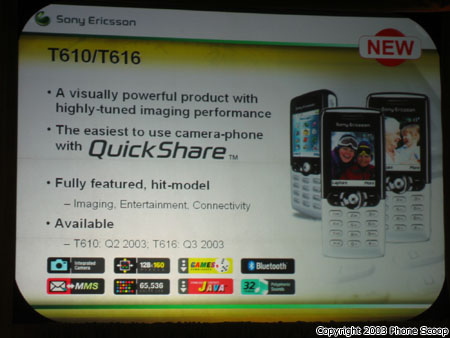
The new Sony Ericsson flagship - the T610/T616. The T610 will be available next quarter, but the T616 won't hit the market until Q3. The T610 has some nice design elements, like a rubberized, textured rest for your fingertips on the back, and concave sides to make it easier to grip. The 65,000-color STN display looks quite good, although not as nice as a TFT-type display.
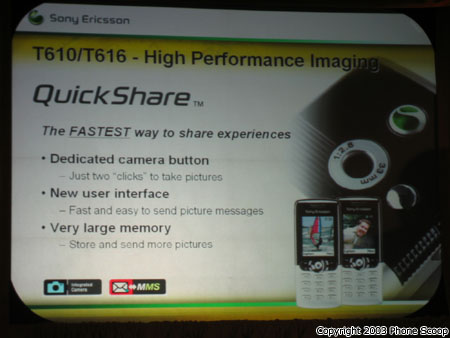
The new "QuickShare" simply means that taking and sending pictures has been designed to require as few button-presses as possible. I tried it out, and it is pretty quick. It's not a revolutionary feature, (if you could even call it a feature,) but it's these kind of little improvements that make camera phones more fun and less of a hassle.
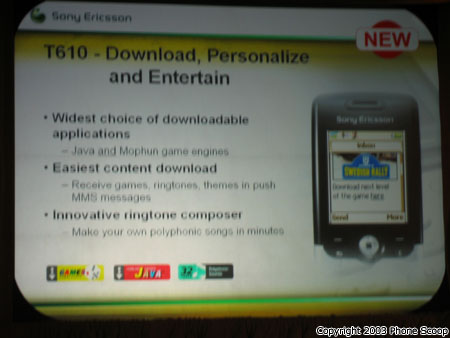
The T610 includes Java and the Mophun game platform. This is very smart; obviously Java is an important feature in a high-end phone, and if Mophun was only in the T3xx series phones, it would not be a very attractive platform for developers. The ringtone composer is pretty neat. Polyphonic ringtone composers have traditionally been a tricky proposition - there are just to many notes in the average polyphonic ringtone - no one has the time to sit down and enter all the notes. So Sony Ericsson created a composer that lets you mix together different "building block" beats to create your own unique tune. The resulting ringtones sound pretty good.
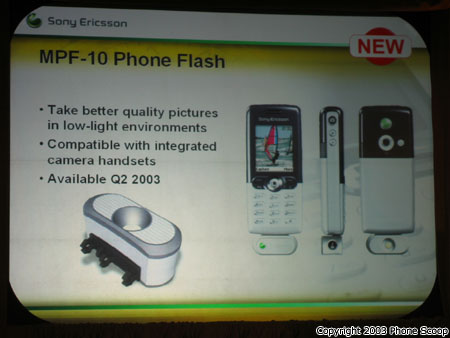
The attachable flash has its own dedicated shutter release button. When the flash is attached, you can choose whether or not to use the flash by which shutter release button you press. Right next the camera lens on the T610 is the external antenna connector. Included with the phone is a small mirror you can place there, which lets you frame self-portraits using the self-timer. The max. camera resolution is 288x352.
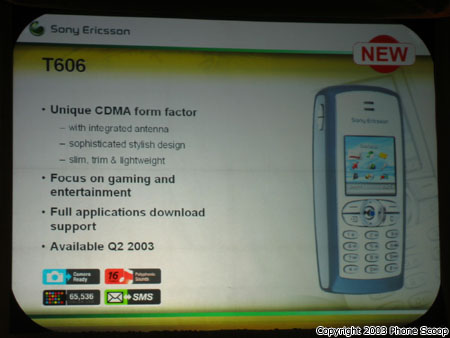
The T606 is Sony Ericsson's first BREW phone. It also sports an internal antenna - a rarity for CDMA phones. The interface is similar to the T610 and T608 - on all three, the menus look fantastic. The T606 and T608 also sport the same concave sides that make the T610 a pleasure to hold.
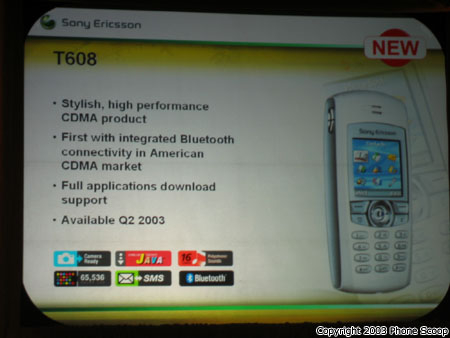
The T608 is the real ground-breaker in the group - the first CDMA phone with Bluetooth for North America. The Bluetooth will be useable for 1xRTT high-speed data with PDAs and laptops, which is pretty exciting. They had a Bluetooth-enabled Sony Clie set up on the Internet via Bluetooth and a T608 on Sprint PCS. Both the T608 and T606 support a camera attachment.
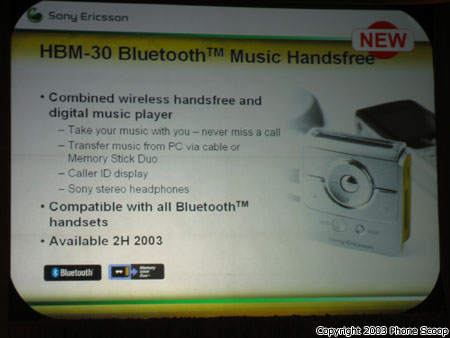
The HBM-30 looks like a neat little device for music lovers. It's basically a small MP3 player with a Memory Stick Duo slot. But it also features a microphone and Bluetooth, to double as an interface for your phone. You can leave you phone in your pocket, and when you receive a call, the music pauses, the caller-ID is shown on the display, and you can answer the call and listen through your regular headphones. So where other MP3 phone accessories center around the phone, this one seems to revolve more around the MP3 player.
Unfortunately, I didn't get a picture of the slide, but Sony Ericsson also announced a desktop speakerphone stand accessory. This is kind of like the plug-in speakerphone that Motorola makes, except it is in the form of a stand that is designed to stay on your desk.
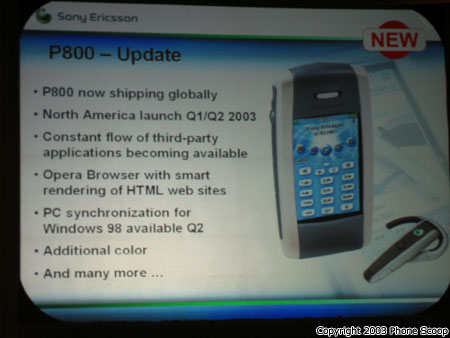
One small announcement that many have overlooked is that the P800 will soon be available in a new color: Mineral Gray. This is great news for the U.S. market, where having a "serious-looking" phone is generally more of an issue than in other parts of the world. In other P800 news, Sony Ericsson is starting to emphasize the benefits of the P800 for large companies. AppForge recently announced that it has ported its Visual Basic platform to the P800, and Sony Ericsson has a new alliance with IBM to promote the P800 for enterprises.
That's it for today. I'll have full specs and feature lists later on in the week.


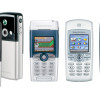 Sony Ericsson Launches 2003 Phones
Sony Ericsson Launches 2003 Phones
 iPhone 15 Series Goes All-In on USB-C and Dynamic Island
iPhone 15 Series Goes All-In on USB-C and Dynamic Island
 Samsung S24 Series Adds More AI, Updates the Hardware
Samsung S24 Series Adds More AI, Updates the Hardware
 Sony Ericsson T608
Sony Ericsson T608
 Sony Ericsson T606
Sony Ericsson T606
 Sony Ericsson T316
Sony Ericsson T316


